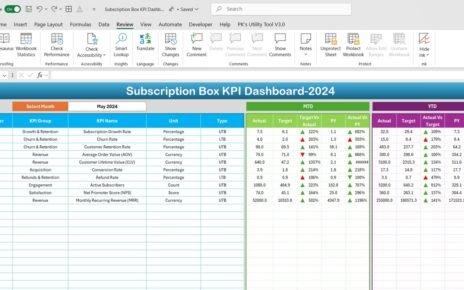Private equity firms today face constant pressure to track their performance effectively, stay on top of targets, and make quick, data-driven decisions. Having a Private Equity KPI Dashboard in Excel is a game-changer in this regard. It’s a powerful tool that organizes your key performance indicators (KPIs) in one place, making it easy to monitor progress, compare results, and act fast when needed. In this guide, we’ll dive into the setup, features, best practices, and even opportunities to improve your Private Equity KPI Dashboard to make it as effective as possible Private Equity KPI Dashboard in Excel.
Click to buy Private Equity KPI Dashboard in Excel
What Is a Private Equity KPI Dashboard in Excel?
Simply put, a Private Equity KPI Dashboard in Excel is a specialized spreadsheet designed for private equity teams to view and analyze their performance metrics. By bringing all KPIs together in one easy-to-use platform, this dashboard lets you track progress month-to-month, year-to-date, and even year-over-year. With this setup, you can make comparisons, spot trends, and act faster—all essential for meeting financial targets and making informed investment decisions.
Click to buy Private Equity KPI Dashboard in Excel
Key Features of the Private Equity KPI Dashboard
The Private Equity KPI Dashboard consists of seven main worksheets that are each built to support different aspects of data tracking and reporting. Let’s take a look at each one.
Home Sheet
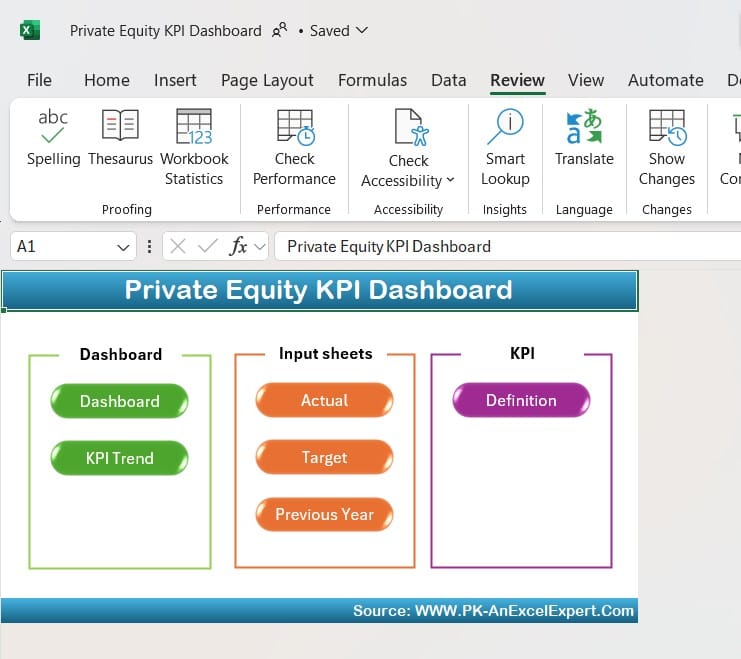
Click to buy Private Equity KPI Dashboard in Excel
- The Home Sheet serves as your main control panel. It includes six buttons, each linking to different parts of the dashboard, making navigation easy and fast.
Dashboard Sheet Tab
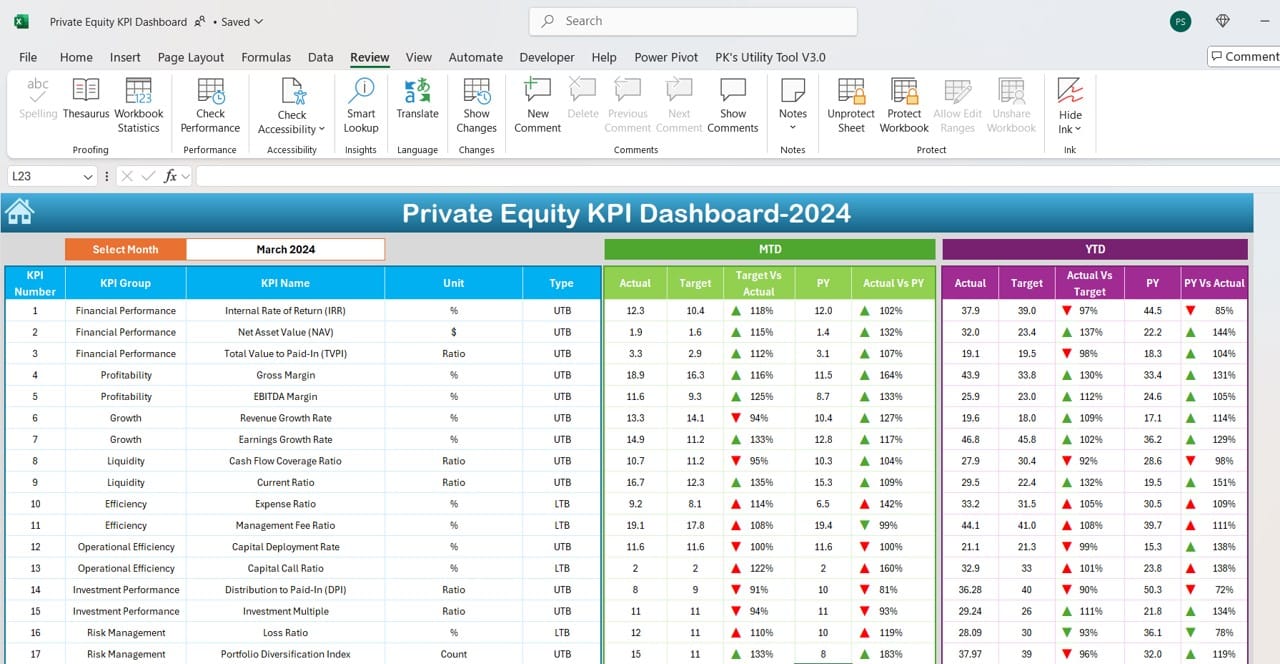
Click to buy Private Equity KPI Dashboard in Excel
- The Dashboard tab is where you’ll find the main display of all your KPIs. Here’s what it includes:
- Month-to-Date (MTD) and Year-to-Date (YTD) metrics, alongside target numbers and figures from the previous year.
- Drop-down selection for changing the month (located in cell D3), which instantly updates the numbers for easy month-to-month comparisons.
- Conditional Formatting: Up and down arrows signal whether actuals are above or below targets, helping you spot performance trends immediately.
KPI Trend Sheet Tab
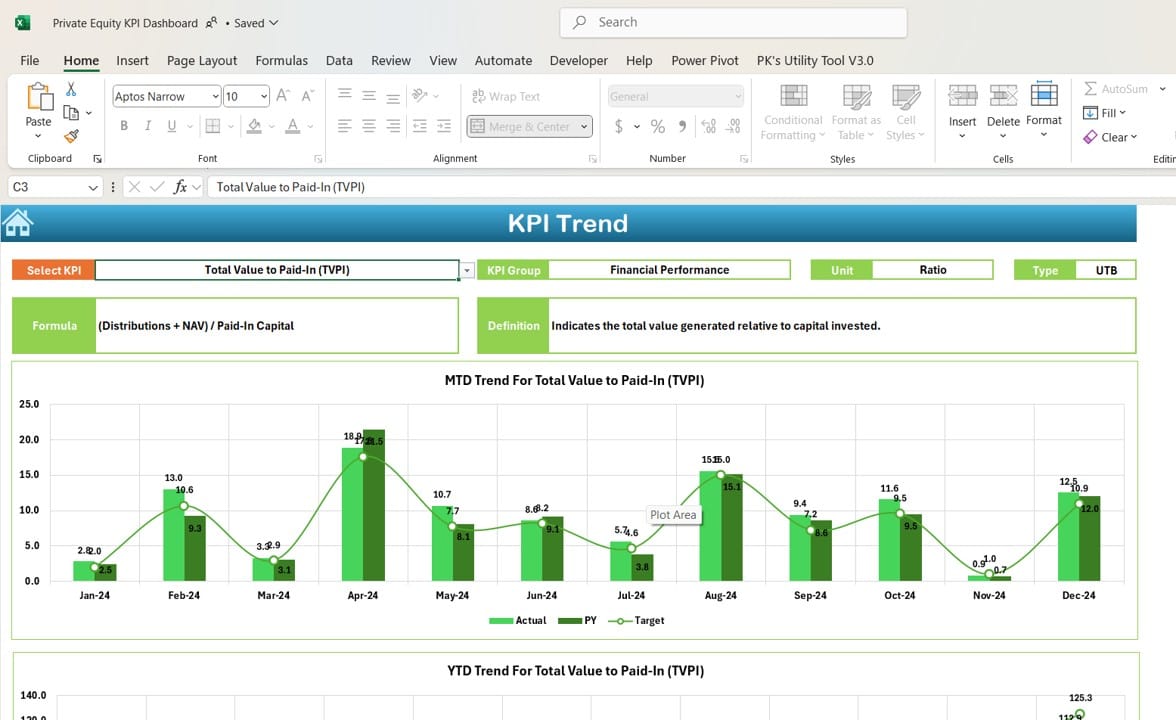
KPI Trend Sheet
Click to buy Private Equity KPI Dashboard in Excel
- The KPI Trend sheet gives a closer look at each KPI. Selecting a KPI from the drop-down menu in cell C3 reveals:
- The KPI’s group, unit, type (whether a higher or lower number is better), and formula, as well as its definition.
- MTD and YTD charts that show trends over time, comparing actual performance to targets and previous year data.
Actual Numbers Input Sheet
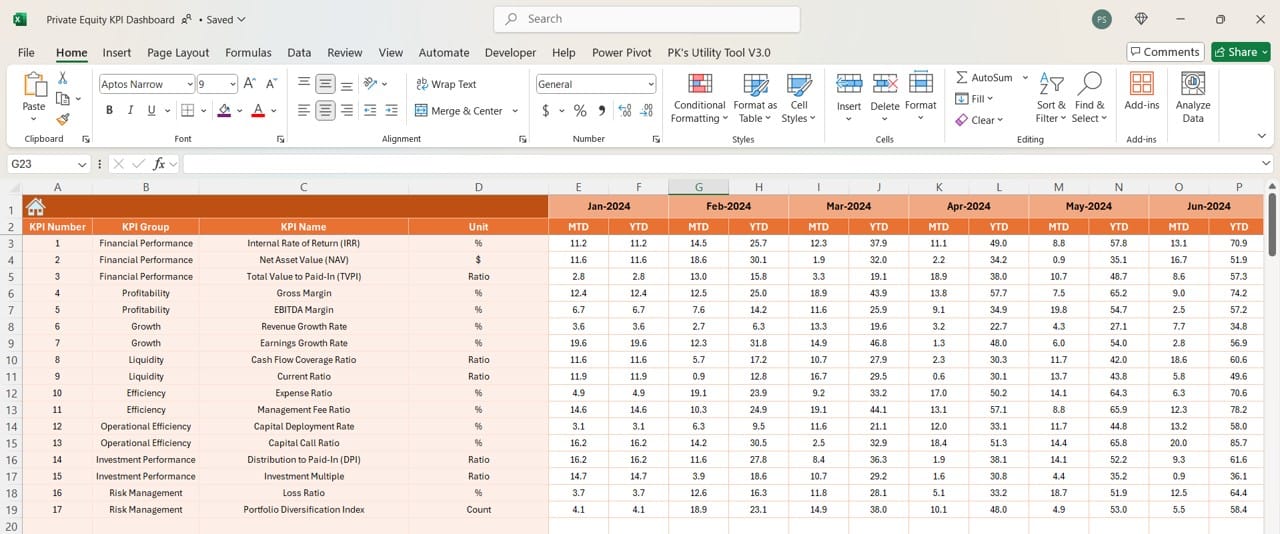
Click to buy Private Equity KPI Dashboard in Excel
- This is where you enter actual performance numbers for each KPI. Simply input the month in cell E1 and fill in the data for Month-to-Date (MTD) and Year-to-Date (YTD) values.
Target Sheet Tab
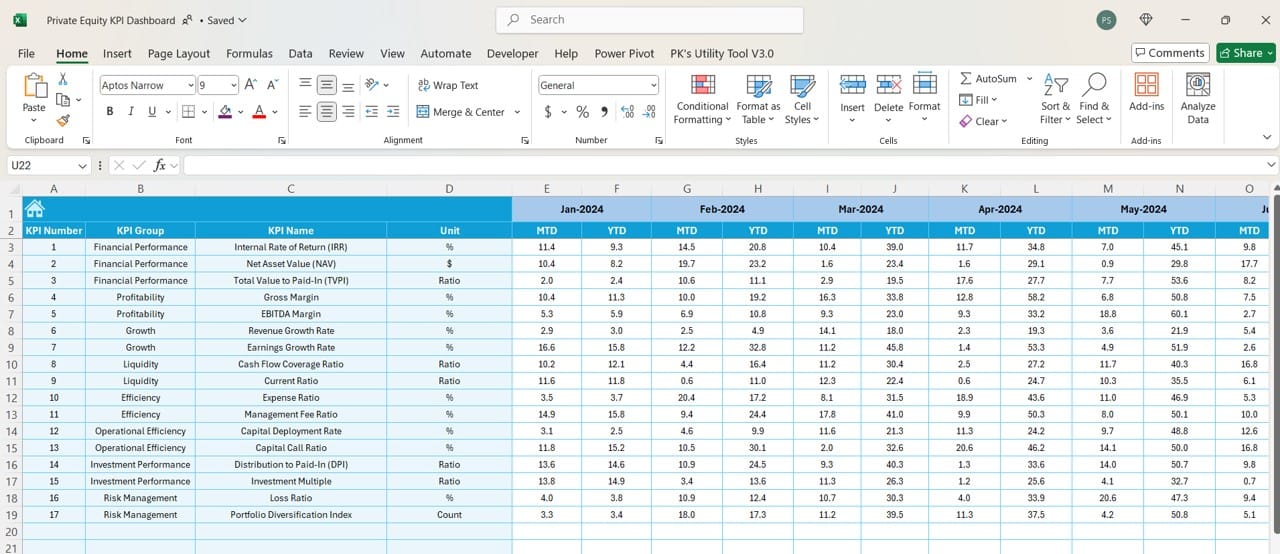
Target Sheet
Click to buy Private Equity KPI Dashboard in Excel
- In the Target sheet, you’ll enter the target numbers for each KPI. Like with actual numbers, you’ll enter MTD and YTD targets here to allow for easy comparison against actual performance.
Previous Year Number Sheet Tab
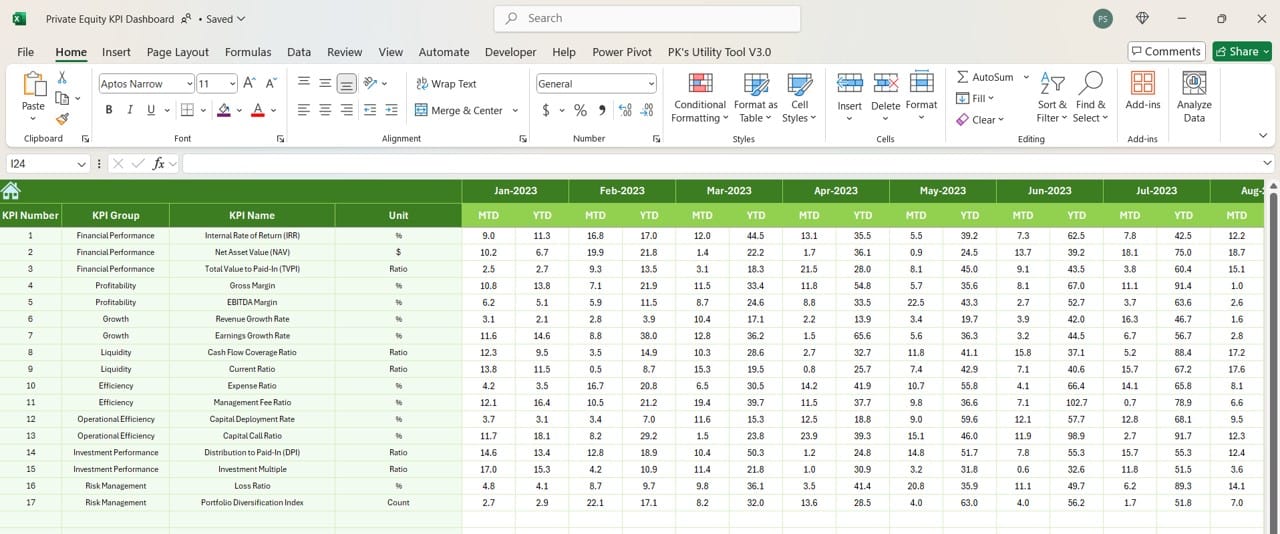
Click to buy Private Equity KPI Dashboard in Excel
- This tab is dedicated to last year’s figures, letting you track year-over-year performance for each KPI.
KPI Definition Sheet Tab
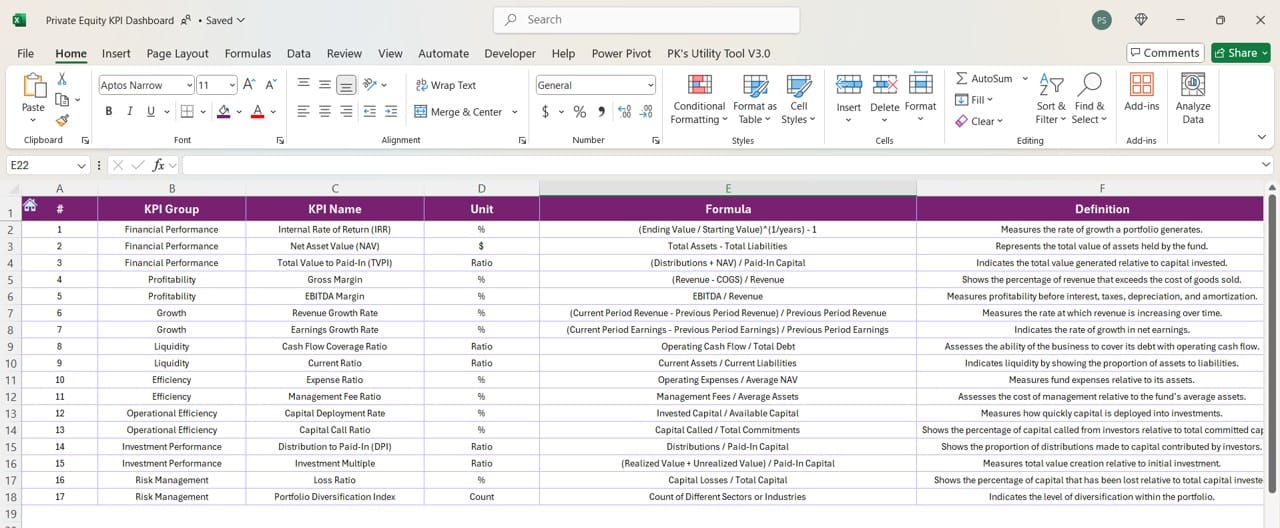
Click to buy Private Equity KPI Dashboard in Excel
- Finally, the KPI Definition sheet contains comprehensive details for each KPI. This includes its name, group, unit, formula, and definition, making it easier for team members to understand each metric’s purpose.
Benefits of Using a Private Equity KPI Dashboard in Excel
Let’s take a closer look at the benefits you’ll gain by using this dashboard in your private equity work:
- Centralized Data Management: All your KPIs are stored in one place, making it easy to track, manage, and update data quickly and efficiently.
- Real-Time Performance Insights: By selecting different months or KPIs, you can instantly view updated performance data, which is essential for fast decision-making.
- Easy Data Visualization: Excel’s built-in features allow you to create color-coded trends and performance indicators that are easy to read and interpret at a glance.
- Historical Comparison for Better Context: Including last year’s data allows for year-over-year comparison, helping you assess performance over time and make more strategic decisions.
- Simple and Customizable: Since this dashboard is in Excel, you have the flexibility to adapt it as needed, tailoring the dashboard to fit your firm’s specific KPIs.
Best Practices for Using a Private Equity KPI Dashboard
Click to buy Private Equity KPI Dashboard in Excel
To get the most out of your Private Equity KPI Dashboard, consider these best practices:
- Keep Data Up-to-Date: Regularly update your actual and target data to ensure metrics are accurate and up-to-date.
- Tailor KPIs to Your Needs: Define KPIs that align with your company’s goals and performance priorities. Make sure everyone on your team understands what each KPI measures and why it matters.
- Maintain Data Consistency: Use verified data sources for your metrics to ensure accuracy and reliability across the board.
- Use Conditional Formatting to Highlight Trends: Take advantage of Excel’s conditional formatting features, like color-coding and arrows, to make trends more visible.
- Reassess KPIs and Targets Periodically: Review and adjust KPIs and targets annually or as needed to keep them aligned with your strategic objectives.
Opportunities for Improvement in Private Equity KPI Dashboards
While the KPI dashboard is a fantastic tool, there are always opportunities for improvement:
- Automate Data Entry: By using Excel VBA macros or connecting your dashboard to external data sources, you can reduce manual data entry, saving time and reducing the risk of errors.
- Enhance Security: Sensitive financial data should be protected. Consider password-protecting certain sheets or limiting access to key personnel.
- Increase Interactivity: Adding interactive features, like slicers, can make it easier to filter data based on specific categories, such as fund or region.
- Integrate with BI Tools: For more advanced data visualization, consider linking your dashboard with business intelligence tools like Power BI.
Click to buy Private Equity KPI Dashboard in Excel
Frequently Asked Questions (FAQs)
Q. What types of KPIs should I track in a Private Equity Dashboard?
Common KPIs include Internal Rate of Return (IRR), Net Asset Value (NAV), Cash Flow, and Expense Ratios. You may also track KPIs like Revenue Growth, Profit Margin, and Exit Multiples for specific portfolio companies.
Q. How often should I update the data in the KPI Dashboard?
Ideally, you should update MTD figures monthly and YTD data quarterly. This frequency keeps your data current without overwhelming your team with constant updates.
Q. Can I automate this KPI Dashboard in Excel?
Yes, automation is possible! You can use Excel VBA macros or connect the dashboard to databases or APIs for automatic data updates, reducing manual input and saving time.
Q. How can I customize the KPIs in the dashboard?
You can easily add or modify KPIs by updating the KPI Definition and Target sheets. Be sure to adjust linked formulas or charts in the Dashboard and Trend sheets to reflect these changes.
Q. What are the best ways to visualize trends in the dashboard?
Excel’s trendlines, conditional formatting, and color-coded charts work well to highlight changes in performance and make data more visually accessible.
Conclusion
A Private Equity KPI Dashboard in Excel is an invaluable asset for tracking KPIs, monitoring performance, and making quick, data-driven decisions. By consolidating all relevant metrics in one place, it gives your private equity team a clear view of performance, helping you stay aligned with your goals. Following best practices and continuously refining your dashboard will ensure it remains a powerful tool in achieving your investment objectives.
Click to buy Private Equity KPI Dashboard in Excel
View this post on Instagram
Visit our YouTube channel to learn step-by-step video tutorials
Click to buy Private Equity KPI Dashboard in Excel


